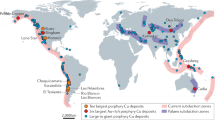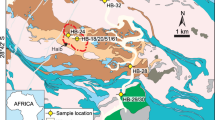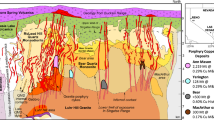Abstract
Porphyry copper systems supply about 75% of the world’s copper1. They form above subduction zones and are preferentially associated with calc-alkaline magmas1,2. Such magmas result from continuous iron depletion during differentiation, in contrast to tholeiitic magmas that show initial iron enrichment during differentiation3. The formation of calc-alkaline magmas is favoured by high water content and oxygen fugacity4,5,6,7. These characteristics, as well as magmatic metal contents, are thought to be imparted in the mantle source by fluids of the subducted slab8,9,10. Yet this process does not explain why porphyry copper systems preferentially occur in thicker arcs1,2. Here I present a statistical assessment of more than 40,000 published geochemical analyses of magmatic rocks from 23 Quaternary-aged volcanic arcs worldwide. I find that magmas of thicker arcs are systematically more calc-alkaline and more depleted in copper than magmas of thinner arcs. This implies that the missing copper in the former accumulates as copper sulphides within or at the base of thicker arcs. Such copper accumulations are an essential step in forming porphyry systems11,12,13. These results suggest that the thickness of the overriding plate provides a more important control on magma differentiation than the composition of the mantle source, and can explain the preferential association of porphyry copper systems with calc-alkaline magmas and thicker arcs.
This is a preview of subscription content, access via your institution
Access options
Subscribe to this journal
Receive 12 print issues and online access
$259.00 per year
only $21.58 per issue
Buy this article
- Purchase on Springer Link
- Instant access to full article PDF
Prices may be subject to local taxes which are calculated during checkout


Similar content being viewed by others
References
Sillitoe, R. H. Porphyry copper systems. Econ. Geol. 105, 3–41 (2010).
Cooke, D., Hollings, P. & Walshe, J. L. Giant porphyry deposits: Characteristics, distribution, and tectonic controls. Econ. Geol. 100, 801–818 (2005).
Miyashiro, A. Volcanic rock series in island arcs and active continental margins. Am. J. Sci. 274, 321–355 (1974).
Zimmer, M. M. et al. The role of water in generating the calc-alkaline trend: New volatile data for Aleutian magmas and a new Tholeiitic Index. J. Petrol. 51, 2411–2444 (2010).
Berndt, J., Koepke, J. & Holtz, F. An experimental investigation of the influence of water and oxygen fugacity on differentiation of MORB at 200 MPa. J. Petrol. 46, 135–167 (2005).
Sisson, T. W. & Grove, T. L. Experimental investigations of the role of H2O in calc-alkaline differentiation and subduction zone magmatism. Contrib. Mineral. Petrol. 113, 143–166 (1993).
Osborn, E. F. Role of oxygen partial pressure in the crystallization and differentiation of basaltic magma. Am. J. Sci. 257, 609–647 (1959).
Mungall, J. E. Roasting the mantle: Slab melting and the genesis of major Au and Au-rich Cu deposits. Geology 30, 915–918 (2002).
Gill, J. B. Orogenic Andesites and Plate Tectonics (Springer, 1981).
Kelley, K. A. & Cottrell, E. Water and the oxidation state of subduction zone magmas. Science 325, 605–607 (2009).
Lee, C-T.A. et al. Copper systematics in arc magmas and implications for crust–mantle differentiation. Science 336, 64–68 (2012).
Sillitoe, R. H. Copper provinces. SEG Spec. Pub. 16, 1–18 (2012).
Shafiei, B., Haschke, M. & Shahabpour, J. Recycling of orogenic arc crust triggers porphyry Cu mineralization in Kerman Cenozoic arc rocks, southeastern Iran. Miner. Deposita 44, 265–283 (2009).
Lee, C-T. A. et al. The redox state of arc mantle using Zn/Fe systematics. Nature 468, 681–685 (2010).
Dauphas, N. et al. Iron isotopes may reveal the redox conditions of mantle melting from Archean to present. Earth Planet. Sci. Lett. 288, 255–267 (2009).
Coulon, C. & Thorpe, R. S. Role of continental crust in petrogenesis of orogenic volcanic associations. Tectonophysics 77, 79–93 (1981).
Lee, C-T. A., Lee, T. C. & Wu, C-T. Modeling the compositional evolution of recharging, evacuating, and fractionating (REFC) magma chambers: Implications for differentiation of arc magmas. Geochim. Cosmochim. Acta http://dx.doi.org/10.1016/j.gca.2013.08.009 (2013).
Kelley, K. A., Cottrell, E. & Brounce, M. N. The relationship between f O2 and calc-alkaline affinity of arc magmas. Mineral. Mag. 77, 1446 (2013).
Chaussard, E. & Amelung, F. Precursory inflation of shallow magma reservoirs at west Sunda volcanoes detected by InSAR. Geophys. Res. Lett. 39, L21311 (2012).
Annen, C., Blundy, J. D & Sparks, R. S. J. The genesis of intermediate and silicic magmas in deep crustal hot zones. J. Petrol. 47, 505–539 (2006).
Ghiorso, M. S. & Sack, R. O. Chemical mass transfer in magmatic processes. IV. A revised and internally consistent thermodynamic model for the interpolation and extrapolation of liquid–solid equilibria in magmatic systems at elevated temperatures and pressures. Contrib. Mineral. Petrol. 119, 197–212 (1995).
Asimow, P. D. & Ghiorso, M. S. Algorithmic modifications extending MELTS to calculate subsolidus phase relations. Am. Mineral. 83, 1127–1131 (1998).
Jenner, F. E., O’Neill, H. St. C., Arculus, R. J. & Mavrogenes, J. A. The magnetite crisis in the evolution of arc-related magmas and the initial concentration of Au, Ag and Cu. J. Petrol. 51, 2445–2464 (2010).
Sun, W., Arculus, R. J., Kamenetski, V. S. & Binns, R. A. Release of gold-bearing fluids in convergent margin magmas prompted by magnetite crystallization. Nature 431, 975–978 (2004).
Nadeau, O., Williams-Jones, A. E. & Stix, J. Sulphide magma as a source of metals in arc-related magmatic hydrothermal ore fluids. Nature Geosci. 3, 501–505 (2010).
Chiaradia, M., Ulianov, A., Kouzmanov, K. & Beate, B. Why large porphyry Cu deposits like high Sr/Y magmas? Sci. Rep. 2, 685 (2012).
Clark, A. H. Are outsize porphyry copper deposits either anatomically or environmentally distinctive? SEG Spec. Pub. 2, 213–284 (1995).
Tosdal, R. M. & Richards, J. P. Magmatic and structural controls on the development of porphyry Cu±Mo±Au deposits. Rev. Econom. Geol. 14, 157–181 (2001).
Zellmer, G. Some first-order observations on magma transfer from mantle wedge to upper crust at volcanic arcs. Geol. Soc. Lond. Spec. Publ. 304, 15–31 (2008).
Acknowledgements
A review by C-T. A. Lee (Rice University) contributed to significantly improve an earlier version of this work. This study was financially supported by the Swiss National Science Foundation (Project no. 200020_137663).
Author information
Authors and Affiliations
Corresponding author
Ethics declarations
Competing interests
The author declares no competing financial interests.
Supplementary information
Supplementary Information
Supplementary Information (PDF 1320 kb)
Rights and permissions
About this article
Cite this article
Chiaradia, M. Copper enrichment in arc magmas controlled by overriding plate thickness. Nature Geosci 7, 43–46 (2014). https://doi.org/10.1038/ngeo2028
Received:
Accepted:
Published:
Issue Date:
DOI: https://doi.org/10.1038/ngeo2028
This article is cited by
-
Underplated melts control sulfide segregation at the continental crust-mantle transition
Communications Earth & Environment (2024)
-
Copper behavior in arc-back-arc systems: Insights into the porphyry Cu metallogeny of the Gangdese belt, southern Tibet
Mineralium Deposita (2024)
-
Special Issue: Data-Driven Discovery in Geosciences: Opportunities and Challenges
Mathematical Geosciences (2023)
-
Apatite evidence for a fluid-saturated, crystal-rich magma reservoir forming the Quellaveco porphyry copper deposit (Southern Peru)
Contributions to Mineralogy and Petrology (2023)
-
Crucial Geochemical Signal Identification for Cu-Fertile Magmas in Paleo-Tethyan Arc Based on Machine Learning
Mathematical Geosciences (2023)



